Abstract
IBM® Flex System™ V7000 Storage Node complements the next generation of integrated systems and is built on the industry-leading storage virtualization and efficiency capabilities of IBM Storwize® V7000 while being physically integrated into IBM PureFlex™ System or IBM Flex System solutions. It plays the pivotal role of storage in IBM PureSystems™ solutions.
IBM Flex System V7000 Storage Node is derived from the same base technology as the successful IBM Storwize V7000. It inherits unmatched performance and flexibility through internal virtualization and built-in flash memory optimization technologies. It enables external virtualization, consolidation, and tiering, and improves application availability and resource usage for organizations of all sizes.
Introduction
IBM® Flex System™ V7000 Storage Node complements the next generation of integrated systems and is built on the industry-leading storage virtualization and efficiency capabilities of IBM Storwize® V7000 while being physically integrated into IBM PureFlex™ System or IBM Flex System solutions. It plays the pivotal role of storage in IBM PureSystems™ solutions.
IBM Flex System V7000 Storage Node is derived from the same base technology as the successful IBM Storwize V7000. It inherits unmatched performance and flexibility through internal virtualization and built-in flash memory optimization technologies. It enables external virtualization, consolidation, and tiering, and improves application availability and resource usage for organizations of all sizes.
Figure 1 shows the chassis with the IBM Flex System V7000 Storage Node occupying 4x compute bays. It is partially inserted into the IBM Flex System Enterprise Chassis for identification.
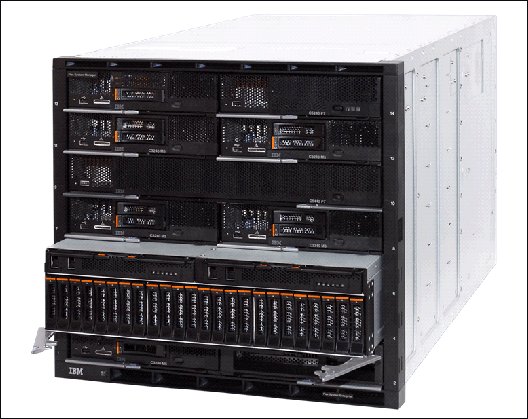
Figure 1. Front view of IBM Enterprise Flex System Chassis with IBM Flex System V7000 Storage Node
Did you know?
After nearly 40 years of network usage, highly efficient real-time compression is available for file-based and block-based disk systems with the IBM Storwize family of systems, including IBM Flex System V7000 Storage Node.
IBM Flex System V7000 Storage Node
- IBM System Storage® Easy Tier® for automated SSD optimization
- IBM Real-time Compression™ for data footprint reduction
Figure 2 shows the role of Flex System V7000 in a PureSystems environment.
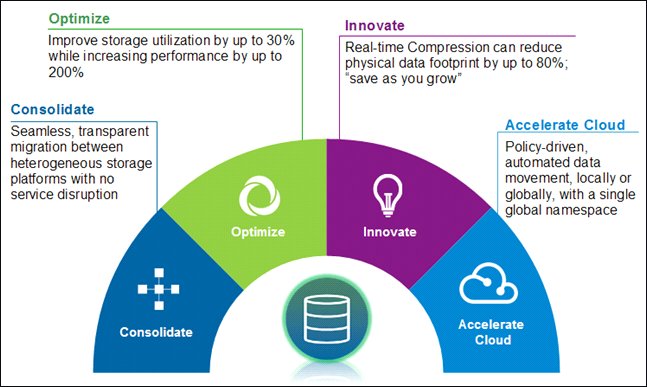
Figure 2. Role of Flex System V7000 in PureSystems
The IBM Flex System V7000 Storage Node is a scalable internal storage system to support the compute nodes of the IBM Flex System environment. It consists of a control enclosure that contains a pair of clustered node canisters and accommodates up to twenty-four 2.5-inch disk drives within the enclosure. Each control enclosure can additionally attach a maximum of two IBM Flex System V7000 Expansion Enclosures that can be inside an IBM Flex System Enterprise Chassis. Up to nine Storwize V7000 Expansions can also be attached externally.
Flex System V7000 highlights
Integrated storage node enhancements
- Physically integrated into Flex System Chassis (plug-and-play integration)
- Automated deployment and discovery
- Integrated into the Flex System Manager Chassis map
- FCoE optimized offering (plus FC and iSCSI)
Offering description
- Integrated storage system (double high/full wide)
- Advanced storage efficiency capabilities
- Thin provisioning, IBM FlashCopy®, Easy Tier, Real-time Compression, and nondisruptive migration
- External virtualization for rapid data center integration
- Metro Mirror and Global Mirror for multi-site recovery
- Scalable up to 240 SFF drives (HDD and SSD)
- Clustered systems support up to 960 SFF drives and 4x bandwidth
- Supports Flex System compute nodes across multiple chassis
Decreased deployment time and faster time to value
- All connections to data and management networks are made instantly upon insertion in to the Flex System Chassis.
- Eliminates multiple external optical cables, SFPs, management network cables, power cords, and so on.
- There is rapid setup and configuration through integrated CMM/FSM management.
- There is automatic detection of Storage Node insertion and automatic management configuration.
- There is rapid allocation and provisioning of server, storage, and networking resources through a single GUI.
- Has an easy “all-in-one-box” deployment of integrated solutions.
Functionally enhanced chassis-based management and monitoring
- Flex System Management uses Flex System V7000 management.
- Supports detailed power and thermal monitoring through NGP Management Node Chassis Map and Advanced Energy Manager.
Decreased time to add storage
- Rapid setup and configuration through integrated CMM/FSM management of an additional Storage Node
- Automatic addition of a new Storage Node to existing FSM managed storage pool
More efficient and reliable storage for virtual server hosting
- An in-chassis Storage Node can be easily configured and managed by server administrators without involving external SAN/storage and network administrators.
- Having the storage in the same chassis as the servers that are using it reduces the chance of the storage getting accidentally disconnected from the servers (that is, it eliminates the risk of disconnection or damage of external cables).
Flex System V7000 components
- Flex System V7000 hardware:
- IBM Flex System V7000 Control Enclosure
- IBM Flex System V7000 Expansion Enclosure
- Flex System V7000 software:
- IBM Storwize Family Software for Flex System V7000 V7.1
Figure 3 shows both control and expansion enclosures with SAS connecting cables.
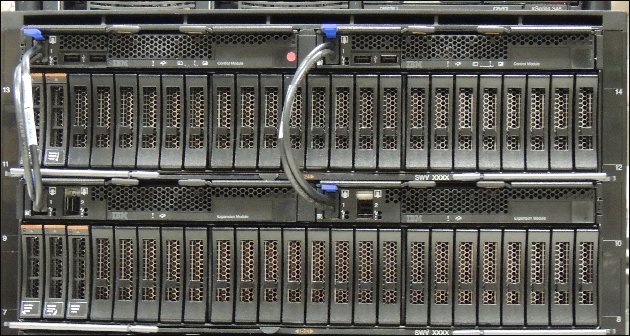
Figure 3. Flex System V7000 control and expansion enclosures
Flex System V7000 part numbers
Table 1. IBM Flex System V7000 Storage Node part numbers
| Machine Type / model |
Feature number / Part number |
Description |
| 4939-A49, 4939-H49, and 4939-X49 | AD00 / 4939H49 | IBM Flex System V7000 Control Enclosure |
| 4939-A29, 4939-H29, and 4939-X29 | AD01 / 4939H29 | IBM Flex System V7000 Expansion Enclosure |
Key prerequisites
IBM Flex System V7000 Storage Node requires the following prerequisites:
- Flex System V7000 Control Enclosure with optional Flex System V7000 or Storwize V7000 Expansion Enclosures.
- IBM Storwize Family Software for Flex System V7000 V7.1 or later, for operation. Usage of the software is gained through the acquisition of Flex System V7000 software licenses.
- Flex System Enterprise Chassis with all the necessary components to support Flex System V7000 as a node, and a switch module supporting the connectivity option that is configured with the Flex System V7000.
Flex System V7000 product overview
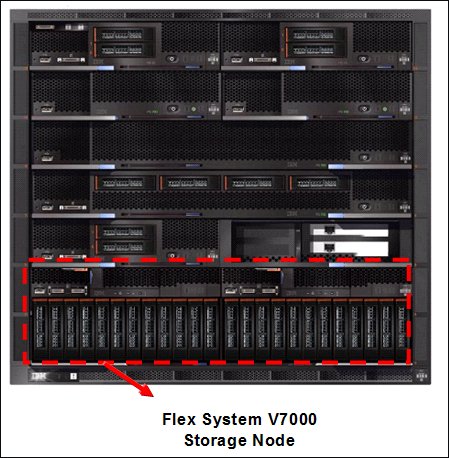
Figure 4. IBM Flex System V7000 Storage Node in IBM Flex System Enterprise Chassis
Enclosure features
The Flex System V7000 Control Enclosure (Model A49, X49, H49) has the following features:
- Double-high, full-wide node for use in an IBM Flex System Enterprise Chassis
- Two node canisters with 16 GB cache (8 GB per canister)
- 8 Gb FC, 10 Gb iSCSI, and 10 Gb FCoE host connectivity options
- Two management modules (one per canister) with integrated connectivity to the Flex System Chassis Management Module
- Two 6 Gb SAS ports (one per canister) for attachment of a Flex System V7000 or Storwize V7000 expansion enclosures
- Twenty-four slots for 2.5-inch SAS drives
- Support for the attachment of other storage devices using the FC or FCoE interface to enable use of the External Virtualization function
The Flex System V7000 Expansion Enclosure (Model A29, X29, H29) has the following features:
- Double-high, full-wide node for use in a Flex System Enterprise Chassis
- Dual expansion canisters
- Twenty-four 2.5-inch 6 Gb SAS drive bays
- Four 6 Gb SAS ports (two per canister) for attachment to upstream and downstream enclosures
- Two management modules (one per canister) with integrated connectivity to the Flex System Chassis Management Module
For a complete and updated list of IBM Flex System V7000 Storage Node configuration limits and restrictions, see the following link:
http://www.ibm.com/support/docview.wss?uid=ssg1S1004369
Product specifications
Table 2. Control and expansion enclosure specifications
| Feature | Description |
| Flex System V7000 Control Enclosure Node Canister (x 2) |
The principal components of the node canister are:
|
| Flex System V7000 Expansion Enclosure (maximum 2) Storwize V7000 Expansion Enclosure (maximum 9)a |
Each of the two expansion canisters contains the following items:
Each of two expansion canisters contain the following items:
|
| Chassis support | IBM Flex System Enterprise Chassis |
| Host attachment | SAN-attached 16, 8 Gbps Fibre Channel, 10 Gigabit Ethernet (GbE), and FCoE and iSCSI host connectivity |
| Host interface card | There are a number of HIC adapters that can be used in the controller node canister, depending on the connectivity type (FC, FCoE, or iSCSI) and speed that are required. For the latest support matrixes and combinations, see the IBM System Storage Interoperability Center (SSIC): http://www.ibm.com/systems/support/storage/ssic/interoperability.wss |
| Maximum supported drives | 240 per control enclosure, 960 per clustered system |
| Supported systems | Windows on IBM X-Architecture® Compute nodes, VMware on IBM X-Architecture Compute nodes, Linux on IBM X-Architecture Compute nodes, IBM AIX® on IBM Power Systems™ Compute nodes, Linux on IBM Power Systems Compute nodes, VIOS on IBM Power Systems Compute nodes, and IBM System i® on IBM Power Systems Compute nodes |
| RAID levels | RAID 0 (striping, no redundancy), RAID 1 (mirroring between two drives), RAID 5 (striping, can survive one drive fault), RAID 6 (striping, can survive two drive faults), and RAID 10 (RAID 0 on top of RAID 1) |
| Copy services | FlashCopy, Metro Mirror - Synchronous Remote Copy, and Global Mirror - Asynchronous Remote Copy |
| Management software | IBM Storwize Family Software for Flex System V7000 V7.1 |
| LAN/SAN connectivity support | There are a number of Flex Chassis I/O module switches that can be used in conjunction with the controller node canister I/O adapter. These are dependent on connectivity type (FC, FCoE, iSCSI) and speed required. For the latest support matrixes and combinations, see the IBM System Storage Interoperability Center (SSIC): http://www.ibm.com/systems/support/storage/ssic/interoperability.wss |
| Customer Replaceable Unit (CRU) | The following parts or features are designated as Tier 1 CRUs and hot-swappable, which are easily accessible for removal or replacement:
|
As shown in Figure 5, the control canister has one SAS2 port per canister for the connection of expansion enclosures to add capacity. There are also two USB connections that available to support maintenance actions as required.
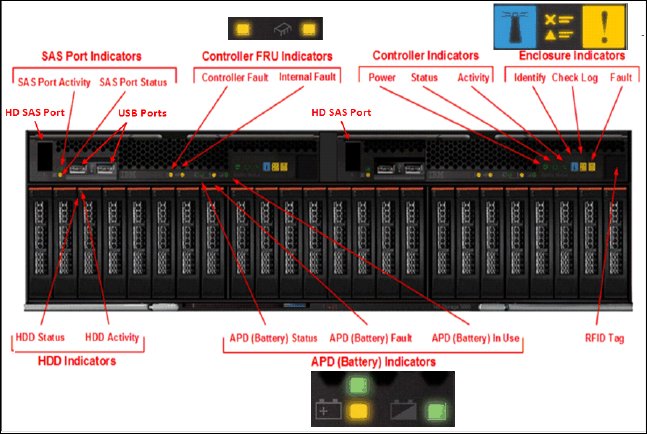
Figure 5. Control enclosure with connection ports and indicators
Table 3 shows the physical dimensions of the control and expansion enclosures and their weight when they are fully populated with disks.
Table 3. Physical dimensions and weight of enclosures
| Enclosure | Height mm (in.) | Width mm (in.) | Depth | Max weight |
| 24 drive-slot control enclosures 4939-X49 | 110 (4.4) | 432 (17) | 505 (19.9) | 27.1 kg (61 lb) |
| 24 drive-slot expansion enclosures 4939-X29 | 110 (4.4) | 432 (17) | 505 (19.9) | 25.1 kg (55.4 lb) |
Table 4 shows the different environmental requirements.
Table 4. Temperature requirements
| Environment | Ambient temperature | Altitude | Relative humidity | Maximum wet bulb temperature |
| 200 W operating | 5°C to 40°C (41°F to 104°F) |
0 to 2133 m (0 to 7000 ft) |
8% to 80% non-condensing | 23°C (73°F) |
| 5°C to 35°C (41°F to 95°F) |
2134 to 3048 m (7001 to 10000 ft) |
|||
| 400 W operating | 5°C to 35°C (41°F to 95°F) |
0 to 2133 m (0 to 7000 ft) |
8% to 80% non-condensing | 23°C (73°F) |
| 5°C to 30°C (41°F to 86°F) |
2134 to 3048 m (7001 to 10000 ft) |
|||
| Non-operating | 1°C to 50°C (34°F to 122°F) |
-305 to 12192m (-1000 to 40000 ft) |
8% to 80% non-condensing | 29°C (84°F) |
| Storage | 1°C to 60°C (34°F to 140°F) |
5% to 80% non-condensing | ||
| Shipping | -40°C to 60°C (-40°F to 140°F) |
5% to 100% condensing, but not precipitating |
Options and feature codes
The IBM Flex System V7000 Storage Node uses new smaller SAS2 cable connectors. These connectors are based on the high density (HD) mini SAS connectors.
There is an adapter on the external IBM Storwize V7000 expansion that changes the HD mini SAS to the mini SAS connection. Figure 6 shows the cabling scheme and the differences in the cable connections of the two expansions.
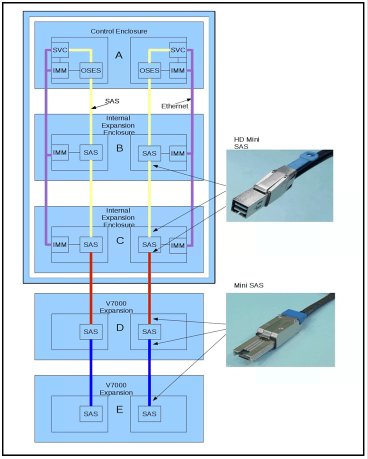
Figure 6. Node cabling - internal SAS and external
For the connections between the IBM Flex System V7000 Control Enclosure and the IBM Flex System V7000 Expansion Enclosure in the chassis, the short cables that are shown in Figure 6 are used and can be ordered. The expansion enclosure cables that are shown in Table 5 are offered with the Flex System V7000.
Table 5. Expansion enclosure cables
| Feature | Part number | Description |
| ADA1 | 00Y4600 | A 0.328 meter SAS cable that is used for the attachment of Flex System V7000 expansion enclosures. |
| ADA6 | 90Y7682 | A 6 meter SAS cable that is used for the attachment of Storwize V7000 expansion enclosures. |
Supported disk drives
Table 6. IBM Flex System V7000 Storage Node internal supported drives
| Feature | Drive capacity | Drive speed |
| AD31 | 146 GB | 15K RPM SAS |
| AD32 | 300 GB | 15K RPM SAS |
| AD21 | 300 GB | 10K RPM SAS |
| AD23 | 600 GB | 10K RPM SAS |
| AD24 | 900 GB | 10K RPM SAS |
| AD25 | 1.2 TB | 10K RPM SAS |
| AD11 | 500 GB | 7.2K RPM NL SAS |
| AD12 | 1 TB | 7.2K RPM NL SAS |
| AD41 | 200 GB | SSD SAS |
| AD42 | 400 GB | SSD SAS |
Table 7 shows IBM Storwize Family Software for Flex System V7000 license information options.
Table 7. License options information
| Program Number / Product ID | Name |
| 5766-NX7 / 5639-NZ7 | IBM Storwize Family Software for Flex System V7000 |
| 5766-RX7 / 5639-RE7 | IBM Flex System V7000 Remote Mirroring Software |
| 5766-EV7 / 5639-EX7 | IBM Flex System V7000 External Virtualization Software |
| 5766-CX7 / 5639-CM7 | IBM Flex System V7000 Real-time Compression Software |
The “IBM Flex System V7000 Storage Node licensing” section provides more information about the usage of the licensing options.
Port and chassis connections
The Network Adapter slots correspond to the following I/O module slots on the IBM Flex System Enterprise Chassis:
- Network Adapter slot 1 in each node canister connects to I/O modules 1 and 2.
- Network Adapter slot 2 in each node canister connects to I/O modules 3 and 4.
Figure 7 shows the adapter slot to IBM Flex System Enterprise Chassis connectivity.
Network Adapters must be installed in pairs (one card per node canister). The following configurations are supported:
- Two or four 10 Gb CNA cards
- Two 8 Gb FC cards
- Two 10 Gb CNA cards and two 8 Gb FC cards
The Network Adapter selection for the node canisters depends on the I/O module switch in the IBM Flex System Enterprise Chassis, where the correct combination provides connectivity at the required protocol (FC, FCoE, or iSCSI) and speed.
For the latest support matrixes and combinations, see the IBM System Storage Interoperability Center (SSIC) at the following link:
http://www.ibm.com/systems/support/storage/ssic/interoperability.wss
For more information about some of these adapters, see the following documents:
- IBM Flex System EN2024 4-port 1Gb Ethernet Adapter, TIPS0845
- IBM Flex System CN4054 10Gb Virtual Fabric Adapter and EN4054 4-port 10Gb Ethernet Adapter, TIPS0868
- IBM Flex System FC3172 2-port 8Gb FC Adapter, TIPS0867
- IBM Flex System FC5022 2-port 16Gb FC Adapter, TIPS0891
- IBM Flex System FC3052 2-port 8Gb FC Adapter, TIPS0869
- IBM Flex System CN4054 10Gb Virtual Fabric Adapter and EN4054 4-port 10Gb Ethernet Adapter, TIPS0868
- IBM Flex System CN4058 8-port 10Gb Converged Adapter, TIPS0909
Specifications and more information about these adapters can be viewed by entering a TIPS reference number at the following link:
http://www.redbooks.ibm.com/redbooks.nsf/portals/
IBM Flex System Enterprise Chassis I/O Module
- The I/O module determines the connectivity type of the IBM Flex System V7000 Storage Node to the compute nodes.
- The storage node canister must have an appropriate Network Adapter that is suitable for the I/O module to communicate by using the required protocol.
- Each of the two node canisters in the IBM Flex System V7000 Storage Node can have up to two Network Adapters. These adapters connect to the I/O modules so that the Storage Node can communicate with and present storage to the compute nodes.
Figure 7 shows the logical connections from the Storage Node canister Network Adapters to the I/O module switches. Each logical connection that is shown in the figure represents four serial links to an I/O module switch. The Network Adapter port uses only one of these four "lanes" per switch; the unused lanes are provided for future options. Each of these individual I/O links or lanes can be wired for 1 Gb or 10 Gb Ethernet, or 8 or 16 Gbps Fibre Channel.
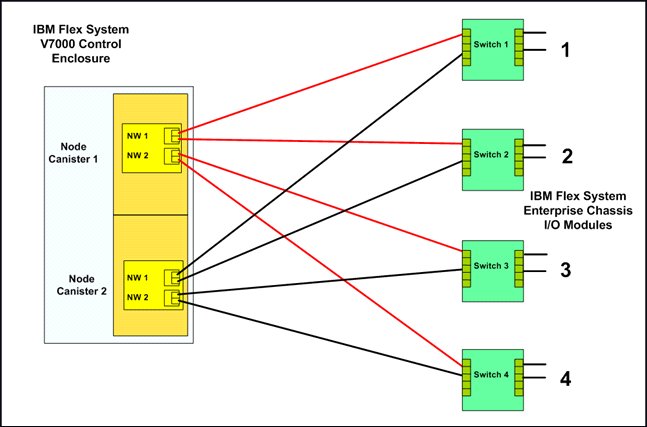
Figure 7. Logical layout of Storage Node to I/O module switch interconnects
The Network Adapter on the IBM Flex System V7000 Control Enclosure canister communicates to switch modules on the IBM Flex System Enterprise Chassis I/O module ports. Some pass-through modules are available as an alternative to switches on the IBM Flex System Enterprise Chassis I/O modules.
For the latest support matrixes and combinations of canister adapters and IBM Flex System Enterprise Chassis I/O Module switches, see the IBM System Storage Interoperability Center (SSIC) at the following link:
http://www.ibm.com/systems/support/storage/ssic/interoperability.wss
Figure 8 shows an example of connectivity of the IBM Flex System V7000 Storage Node canisters to I/O IBM Flex System Enterprise Chassis I/O modules where FC is used:
- The canister network adapters are FC3052 where they connect to I/O modules 3 and 4, which house FC3171 switches.
- The FC3052 and FC3171 combination allows FC switching within IBM Flex System Enterprise Chassis and, if required, connectivity to external SANs.
- External SAN connectivity allows Remote Copy services such as Metro Mirror or Global Mirror to a remote storage system running IBM Storwize Family Software (Storwize V7000, Flex System V7000, or IBM SAN Volume Controller)
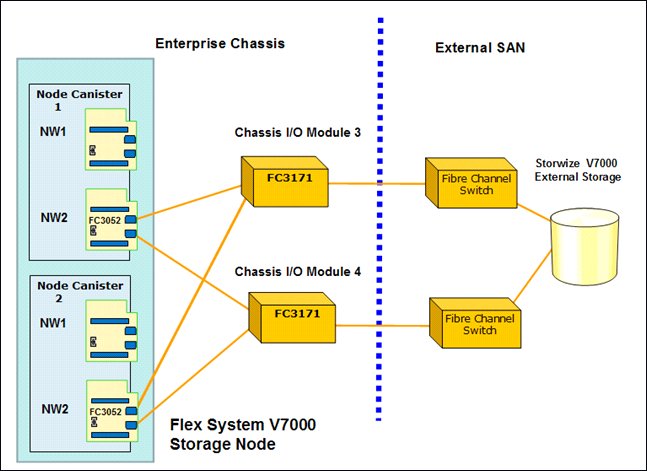
Figure 8. Example of FC connectivity using FC canister adapters and I/O module switches
Power
Table 8. Flex System V7000 power consumption and heat dissipation
| Enclosure | Watts (AC) | Btu per hour |
| Flex System V7000 controller node | 376 | 1283 |
| Flex System V7000 expansion node | 188 | 641 |
Power connectivity and supply are managed through the IBM Flex System Enterprise Chassis. For more information, consult the Power Configurator for exact configuration support for the IBM Flex System V7000 Storage Node on the IBM Flex System Enterprise Chassis. See the following link:
http://www.ibm.com/systems/bladecenter/resources/powerconfig.html
Other feature highlights
Thin provisioning
Thin provisioning has the following features:
- Traditional fully allocated volumes allocate real physical disk capacity for an entire volume even if that capacity is never used.
- Thin-provisioned volumes allocate real physical disk capacity only when data is written to the logical volume.
Volume mirroring
Volume mirroring has the following features:
- Provides a single volume image to the attached host systems while maintaining pointers to two copies of data in separate storage pools.
- Copies can be on separate disk storage systems that are being virtualized. If one copy is failing, IBM Flex System V7000 Storage Node provides continuous data access by redirecting I/O to the remaining copy. When the copy becomes available, automatic resynchronization occurs.
FlashCopy
FlashCopy provides a volume level point-in-time copy function for any storage that is virtualized by IBM Flex System V7000 Storage Node. FlashCopy creates copies for backup, parallel processing, testing, and development, and has the copies available almost immediately.
IBM Flex System V7000 Storage Node includes the following FlashCopy functions:
- Full / Incremental copy: This function copies only the changes from either the source or target data since the last FlashCopy operation and enables completion of point-in-time online backups much more quickly than using traditional FlashCopy.
- Multitarget FlashCopy: IBM Flex System V7000 Storage Node supports copying of up to 256 target volumes from a single source volume. Each copy is managed by a unique mapping and, in general, each mapping acts independently and is not affected by other mappings that share the source volume.
- Cascaded FlashCopy: This function is used to create copies of copies and supports full, incremental, or nocopy operations.
- Reverse FlashCopy: This function allows data from an earlier point-in-time copy to be restored with minimal disruption to the host.
- FlashCopy nocopy with thin provisioning: This function provides a combination of using thin-provisioned volumes and FlashCopy together to help reduce disk space requirements when making copies. There are two variations of this option:
- Space-efficient source and target with background copy: Copies only the allocated space.
- Space-efficient target with no background copy: Copies only the space that is used for changes between the source and target and is referred to as “snapshots”.
- Consistency groups address the issue where application data is on multiple volumes: By placing the FlashCopy relationships into a consistency group, commands can be issued against all of the volumes in the group. This action enables a consistent point-in-time copy of all of the data, even though it might be on a physically separate volume.
FlashCopy mappings can be members of a consistency group, or they can be operated in a stand-alone manner, that is, not as part of a consistency group. FlashCopy commands can be issued to a FlashCopy consistency group, which affects all FlashCopy mappings in the consistency group, or to a single FlashCopy mapping if it is not part of a defined FlashCopy consistency group.
Remote Copy
Remote Copy is an optional licensed feature that is based on the number of enclosures that are used at the configuration location. For licensing details, see the “Remote Copy (Advanced Copy Services: Metro Mirror / Global Mirror)” section. Remote Copy can perform either Metro Mirror or Global Mirror operations:
- Metro Mirror: Provides a synchronous remote mirroring function up to approximately 300 km between sites. As the host I/O completes only after the data is cached at both locations, performance requirements might limit the practical distance.
- Metro Mirror provides fully synchronized copies at both sites with zero data loss after the initial copy is completed.
- Metro Mirror can operate between multiple IBM Flex System V7000 Storage Node systems and is only supported on either FC or FCoE host interfaces.
- Global Mirror: Provides long distance asynchronous remote mirroring function up to approximately 8,000 km between sites. With Global Mirror, the host I/O completes locally and the changed data is sent to the remote site later. This function maintains a consistent recoverable copy of data at the remote site, which lags behind the local site. Global Mirror can operate between multiple IBM Flex System V7000 Storage Node systems and is only supported on FC host interfaces.
Note: If customers change from Global Mirror with change volumes to Metro Mirror, then the Metro Mirror can still have a redundant change volume that is attached to it.
Data migration
With external virtualization, IBM Flex System V7000 Storage Node allows you to bring a system into your storage environment, and quickly and easily migrate data from existing storage systems to IBM Flex System V7000 Storage Node. For licensing requirements, see the “License requirements for migration” section.
This function allows you to accomplish the following tasks:
- Move volumes nondisruptively on to a newly installed storage system.
- Move volumes to rebalance a changed workload.
- Migrate data from other back-end storage to an IBM Flex System V7000 Storage Node managed storage.
IBM System Storage Easy Tier
This feature provides a mechanism to seamlessly migrate hot spots to the most appropriate tier within the IBM Flex System V7000 Storage Node solution. This migration could be to internal drives within IBM Flex System V7000 Storage Node or to external storage systems that are virtualized by IBM Flex System V7000 Storage Node.
Real-time Compression
Real-time Compression has the following features:
- Provides for data compression by using the IBM Random-Access Compression Engine (RACE), which can be performed on a per volume basis in real time on active primary workloads.
- Real-time Compression can provide as much as a 50% compression rate for data that is not already compressed. It can reduce the amount of capacity that is needed for storage, which can help with delaying further growth purchases.
- Real-time Compression supports all storage that is attached to the IBM Flex System V7000 Storage Node, whether it is internal, external, or external virtualized storage.
- A compression evaluation tool that is called the IBM Comprestimator can be used to determine the value of using compression on a specific workload for your environment. For more information, see the following link:
There are compression performance enhancements that are included in IBM Flex System V7000 Storage Node V7.1.x or later, which result in improvements on performance and cache destage latency usage. The most notable improvement is when the compression software detects a block that is unlikely to achieve reasonable compression ratio, and writes the block to the back-end storage without compressing it to avoid unnecessary processing impact.
External Storage Virtualization
With this feature, an external storage subsystem can be attached through Fibre Channel or FCoE to the IBM Flex System V7000 Storage Node (these devices cannot be presented through an iSCSI connection). The devices that are presented are treated as Mdisks and can be mapped to storage pools for volume creation and management. After the storage from the external system is integrated into the IBM Flex System V7000 Storage Node and added to a storage pool, it is available to be virtualized and used by any of the features and functions of the IBM Flex System V7000 Storage Node.
Note: External Storage Virtualization is supported only on FC and FCoE but not iSCSI.
Host attachment interoperability
http://www.ibm.com/support/docview.wss?uid=ssg1S1003908
The IBM POWER7® processor-based systems support three families of operating systems:
- AIX
- IBM i
- Linux
In addition, the Virtual I/O Server can be installed in special virtual servers that provide support to the other operating systems for using features such as virtualized I/O devices, IBM PowerVM® Live Partition Mobility, or PowerVM Active Memory™ Sharing.
For more information about the software that is available on IBM Power Systems servers, see the IBM Power Systems Software™ website at the following link:
http://www.ibm.com/systems/power/software/
The x86 processor compute nodes server supports the following operating systems:
- Microsoft Windows Server 2008
- Microsoft Windows Server 2012
- Red Hat Enterprise Linux
- SUSE Linux Enterprise Server
- VMware ESXi
- VMware vSphere
Note: For more information about the specific versions and service levels that are supported and any other prerequisites, see the IBM ServerProven® website at the following link:
http://www.ibm.com/systems/info/x86servers/serverproven/compat/us/nos/matrix.shtml
IBM Flex System V7000 Storage Node licensing
Mandatory licensing
Base enclosure licensing
Each IBM Flex System V7000 Control Enclosure and each IBM Flex System V7000 Disk Expansion Enclosure uses the IBM Storwize Family Software for Flex System V7000. A quantity of one IBM Storwize Family Software for Flex System V7000 license is required for each enclosure, whether it is a control or expansion enclosure.
For example, an IBM Flex System V7000 Storage Node order consisting of one control enclosure and two IBM Flex System V7000 Disk Expansion enclosures requires three IBM Storwize Family Software for Flex System V7000 licenses, one license for each enclosure.
IBM Storwize Family Software for IBM Flex System V7000 Storage Node includes the following features and capabilities:
- Simplified management with an intuitive GUI to aid rapid implementation and deployment.
- Easy Tier technology for increased storage performance.
- FlashCopy and snapshot functions help support the creation of instant copies of data to help avoid data loss and improve space usage.
- Thin provisioning to help capacity planning.
- Dynamic migration helps speed data migrations from weeks or months to days, eliminating the cost of add-on migration tools and providing continuous availability of applications by eliminating downtime.
- Nondisruptive volume moves across clustered systems. Data mobility was enhanced with greater flexibility for nondisruptive volume moves. IBM Flex System V7000 Storage Node can move volumes nondisruptively between the dual controllers within one enclosure. IBM Flex System V7000 Storage Node supports moving volumes anywhere within a clustered system without disruption of host access to storage.
- Four way clustering of Flex System V7000 control enclosures. IBM Flex System V7000 Storage Node provides increased scalability and performance with four-way clustered systems. Flex System V7000 supports clustered systems with up to four control enclosures, essentially quadrupling the maximum capacity and performance of a single IBM Flex System V7000 Storage Node.
IBM Storwize Family Software for Storwize V7000 for use with Storwize V7000 External Expansion Enclosures
When Storwize V7000 Expansion Enclosures are used as external expansions enclosures with the Flex System V7000 Control Enclosure, each IBM Storwize V7000 Disk Expansion Enclosure (2076-212/224) must have the IBM Storwize Family Software for Storwize V7000 license. A quantity of one IBM Storwize Family Software for Storwize V7000 license is required for each Storwize V7000 Expansion Enclosure.
For example, an IBM Flex System V7000 Storage Node configuration is composed of one Flex System V7000 Control Enclosure, one Flex System V7000 Disk Expansion Enclosure, and three Storwize V7000 expansion enclosures (2076-212/224). This situation requires three IBM Storwize Family Software for Storwize V7000 licenses, one for each enclosure, and two IBM Storwize Family Software for Flex System V7000 licenses.
Optional licensing
External Virtualization
Each IBM Flex System V7000 Storage Node Disk Control Enclosure can attach and manage external storage devices on the SAN in the same way as the SAN Volume Controller. To authorize usage of this function, you must license IBM Flex System V7000 Storage Node External Virtualization Software. You must license the number of storage enclosures that are attached externally to the IBM Flex System V7000 Storage Node. IBM Flex System V7000 Control Enclosures and IBM Flex System V7000 Expansion Enclosures, which are clustered, do not need to be included in this External Virtualization license. However, any IBM Flex System V7000 Control Enclosures or Expansion Enclosures that are SAN-attached and virtualized are included in this license.
A storage enclosure that is externally managed by IBM Flex System V7000 Storage Node is defined as an independently powered, channel-attached device that stores data on magnetic disks or SSDs, such as disk controllers and their respective expansion units, each constituting separate enclosures. Therefore, an enclosure can be either the main controller that houses disk (or SSD) drives or the expansion chassis that houses additional heard disk drives (or SSDs) to expand the total capacity of the storage system. If there is any confusion for an external storage enclosure that does not conform to this definition, consult your IBM sales representative for an equivalent measure that is based on a disk drive count.
For example, if you add a DS5020 consisting of three enclosures to IBM Flex System V7000 Storage Node consisting of one control enclosure and one expansion enclosure, then you need one license with three enclosure authorization feature codes (one for each of the DS5020 enclosures) of the IBM Flex System V7000 External Virtualization software.
Remote Copy (Advanced Copy Services: Metro Mirror / Global Mirror)
To authorize the usage of Remote Copy capabilities of IBM Flex System V7000 Storage Node where the primary and secondary systems have the same number of enclosures at each site, you must purchase a license for IBM Flex System V7000 Remote Mirroring Software with a quantity of licenses that matches the number of licensed enclosures that are managed by IBM Flex System V7000 Storage Node, including each internal enclosure that is licensed with the IBM Flex System V7000 Base Software, each attached Storwize V7000 expansion enclosure with the Storwize V7000 Base Software, and each external enclosure that is licensed with the IBM Flex System V7000 External Virtualization Software.
For example, suppose that your primary system has a DS5020 consisting of three enclosures that are managed by an IBM Flex System V7000 Storage Node consisting of one control enclosure and one expansion enclosure, and you have the same number of enclosures at the secondary system. Then, to authorize remote mirroring for the primary system, you must license the IBM Flex System V7000 Remote Mirroring Software for five enclosures. Assuming that the matching secondary system is also an IBM Flex System V7000 Storage Node, you need five additional enclosure licenses for the secondary system, for a total of 10 enclosure licenses.
For primary and secondary systems with a different number of enclosures that are using Remote Mirroring, the number of licenses that are needed for each system is the number of enclosures on the smaller of the two systems (see scenarios 1 and 2 below).
When multiple production systems replicate to a single disaster recovery system, the number of licenses at the disaster recover system must equal the sum of the licenses at the production systems (see scenario 3 below).
Here are examples about how to license Remote Mirroring software under these licensing rules:
Scenario 1: The primary system is a three-enclosure IBM Flex System V7000 Storage Node with nothing externally virtualized, so it has three base enclosure licenses (IBM Storwize Family Software for Flex System V7000). The secondary system is a two-enclosure IBM Flex System V7000 Storage Node with nothing externally virtualized, so it has two base enclosure licenses (IBM Storwize Family Software for Flex System V7000). The Flex System V7000 Remote Mirroring licensing is two licenses for the primary system plus two licenses for the secondary system, for a total of four licenses.
Scenario 2: The primary system is a one-enclosure IBM Flex System V7000 Storage Node managing a DS5020 that consists of three enclosures, so it has one base system license (IBM Storwize Family Software for Flex System V7000) plus three licenses for IBM Flex System V7000 External Virtualization Software. The secondary system is a three-enclosure Flex System V7000 with nothing externally virtualized, so it has three base system licenses (IBM Storwize Family Software for Flex System V7000). The Flex System V7000 Remote Mirroring licensing is three licenses for the primary system plus three licenses for the secondary system, for a total of six licenses.
Scenario 3: There are three primary systems that replicate to a central disaster recovery system. The three primary systems are as follows:
- A two-enclosure IBM Flex System V7000 Storage Node with nothing externally virtualized, so it has two base system (IBM Storwize Family Software for Flex System V7000) licenses.
- A one-enclosure Flex System V7000 managing a DS5020 consisting of three enclosures, so it has one base system (IBM Storwize Family Software for Flex System V7000) license plus three IBM Flex System V7000 External Virtualization Software licenses.
- A one-enclosure Flex System V7000 with nothing externally virtualized, so it has one base system IBM Storwize Family Software for Flex System V7000 license.
The central disaster recovery system is a nine-enclosure Flex System V7000 with nothing externally virtualized, so it has nine base system (IBM Storwize Family Software for Flex System V7000) licenses. The Flex System V7000 Remote Mirroring licensing would be as follows: a sum of seven licenses for the primary systems plus seven licenses for the central disaster recovery system, for a total of 14 licenses.
Real-time Compression
To authorize that usage of Real-time Compression, you must purchase a Real-time Compression license for IBM Flex System V7000 Storage Node.
Real-time Compression for each licensed enclosure that is managed by IBM Flex System V7000 Storage Node, including each internal enclosure that is licensed with the IBM Flex System V7000 Base Software and each external enclosure that is licensed with the IBM Flex System V7000 External Virtualization Software.
For example, if you have IBM Flex System V7000 Storage Node consisting of one control enclosure and one expansion enclosure that are managing a DS5020 consisting of four enclosures (four External Virtualization licenses), you need a license for the IBM Flex System V7000 Real-time Compression with a quantity of six enclosure authorization features to authorize Real-time Compression for this configuration.
Table 9 shows a summary of all the license options.
Table 9. Optional license summary
| License type | Unit | License name | License required? |
| Enclosure | Base+expansion Physical Enclosure Number | IBM Storwize Family Software for Flex System V7000 | Yes, software license per enclosure. |
| External Virtualization | Physical Enclosure Number Of External Storage | IBM Flex System V7000 External Virtualization Software | Optional add-on feature Yes, software license per external storage enclosure |
| Remote Copy | See the “Remote Copy (Advanced Copy Services: Metro Mirror / Global Mirror)” section | IBM Flex System V7000 Remote Mirroring Software | Optional add-on feature Yes, software license per enclosure |
| Real-time Compression | Physical Enclosure Number | IBM Flex System V7000 Real-time Compression Software | Optional add-on feature Yes, software license per enclosure |
| FlashCopy | N/A | N/A | No |
| Volume Mirroring | N/A | N/A | No |
| Thin Provisioning | N/A | N/A | No |
| Volume Migration | N/A | N/A | No |
| Easy Tier | N/A | N/A | No |
License requirements for migration
With External Virtualization, the IBM Flex System V7000 Storage Node allows customers to bring a system in to their storage environment and quickly and easily migrate data from existing storage systems to IBM Flex System V7000 Storage Node.
To facilitate this migration, IBM allows customers 45 days from the date of purchase of the IBM Flex System V7000 Storage Node to use the External Virtualization function to migrate data from an existing storage system to IBM Flex System V7000 Storage Node. Any usage thereafter, and ongoing usage of the external virtualization function of IBM Flex System V7000 Storage Node, requires the purchase of a Flex System V7000 External Virtualization license at a quantity equal to the capacity that is managed under the IBM Flex System V7000 Storage Node.
Migrations that are performed at later points in time that replace other storage systems with IBM Flex System V7000 Storage Node, and thus requiring temporary virtualization of that external storage system to perform that replacement activity, are granted a 45-day period for usage of External Virtualization without having to purchase a license to complete such a migration effort.
You must make your IBM sales representative aware of your intention and when you will start this migration so that an end date can be tracked. It is your responsibility to ensure that your systems are properly licensed for all external storage that is managed by IBM Flex System V7000 Storage Node after those 45 days.
All license feature codes are listed in Table 11.
Ordering information
Table 10. Ordering IBM Flex System V7000 Storage Node and expansion
| License type | Unit | License name | License required? |
| IBM Flex System V7000 Control Enclosure | 4939-A49, 4939-H49, and 4939-X49 | AD00 / 4939H49 |
|
| IBM Flex System V7000 Expansion Enclosure | 4939-A29, 4939-H29, and 4939-X29 | AD01 / 4939H29 |
|
Table 11. IBM Storwize Family Software for Flex System V7000
| Program Name | Version | Program Number / Product ID |
| IBM Storwize Family Software for Flex System V7000 | 7.1 | 5766-NX7 / 5639-NZ7 |
| IBM Flex System V7000 Remote Mirroring Software | 7.1 | 5766-RX7 / 5639-RE7 |
| IBM Flex System V7000 External Virtualization Software | 7.1 | 5766-EV7 / 5639-EX7 |
| IBM Flex System V7000 Real-time Compression Software | 7.1 | 5766-CX7 / 5639-CM7 |
Related product families
Product families related to this document are the following:
Trademarks
Lenovo and the Lenovo logo are trademarks or registered trademarks of Lenovo in the United States, other countries, or both. A current list of Lenovo trademarks is available on the Web at https://www.lenovo.com/us/en/legal/copytrade/.
The following terms are trademarks of Lenovo in the United States, other countries, or both:
Lenovo®
ServerProven®
X-Architecture®
The following terms are trademarks of other companies:
Intel®, the Intel logo is a trademark of Intel Corporation or its subsidiaries.
Linux® is the trademark of Linus Torvalds in the U.S. and other countries.
Microsoft®, Windows Server®, and Windows® are trademarks of Microsoft Corporation in the United States, other countries, or both.
IBM®, IBM Power®, AIX®, Easy Tier®, FlashCopy®, ibm.com®, PowerVM®, Redbooks®, and Storwize® are trademarks of IBM in the United States, other countries, or both.
Other company, product, or service names may be trademarks or service marks of others.
